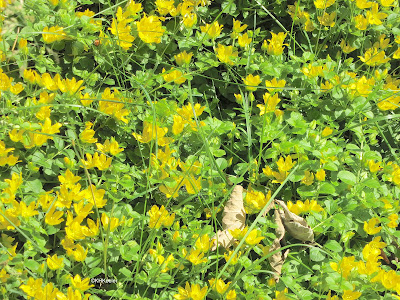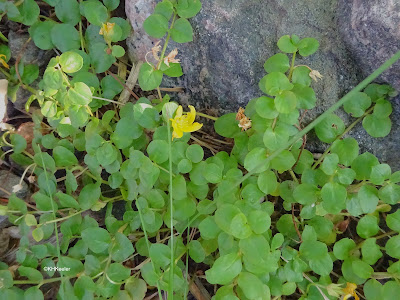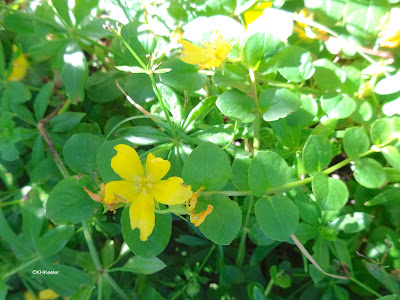Some places in the U.S., creeping Jenny (Lysimachia nummularia, primrose family Primulaceae) is a weed, some places a ground cover.
The genus Lysimachia is found worldwide, with some 160 species. A general name for the genus is loosestrifes, yellow loosestrifes to keep them separate from the quite different purple loosestrifes (Lythrum salicaria and relatives).
The English common name loosestrife is probably a translation, lose strife, turned into loose for easier pronunciation or because seemed more sensible.
(Plant geek note: most species of yellow loosestrifes, Lysimachia species, are tall plants with long narrow leaves, in Europe also called yellow willowherb, the European common name of the plants Americans call fireweed (Epilobium, Chamaenerion). Apparently fireweed/purple willow herb and purple loosestrife grew with yellow loosestrifes along streams and in wet areas, and looked enough alike to be given similar common names. Very confusing in the literature.)
Creeping Jenny, being prostrate, doesn't look much like most of its relatives, nor like fireweeds or purple loosestrifes. So it may be helpful that it has quite a different common name. A close look at the flowers of creeping Jenny and another yellow loosestrife will show you the relationship, however.
 |
Creeping jenny seems an unflattering name. You could also call it moneywort, creeping Charlie and creeping loosestrife. In England it was known as herb twopence, twopence grass, meadow runagate, serpentaria, and several variations on those. But I found creeping Jenny as its name in 1970s English wildflower books and although Grieve in 1932 called it moneywort, she gave creeping Jenny as the first alternative, so creeping Jenny is a long-standing name on both sides of the Atlantic.
The species epithet, nummularia, means "coin-like", referring to the round shape of the leaves. This is probably the origin of moneywort (wort is an old word for plant) and the names referring to twopence, as common names.
 |
| round leaves |
Creeping Jenny was probably brought to the United States as a garden plant, before 1900. Widely planted, it got away in many places. It has multiple characteristics for an effective weed. It can reproduce by seeds or shoots can root at the nodes making them independent of the original plant or broken pieces will root. Generally, seed production is low or absent and even flowers are uncommon in wild populations. Because of the vegetative reproduction, that doesn't stop its spread. It grows well from full sun to deep shade. It preferrs wet habitats, in fact, can grow submerged in water. It readily breaks off, floats in water and then roots wherever it lands.
Lysimachia nummularia has been used as medicinal plant, for treating diahrrea, eczema, and congestion. It was an important European "wound wort," a plant used to treat wounds. The leaves are slightly astringent and antiscorbutic, so they would assist healing. Traditional European herbals say take it internally for vomiting or bleeding. Modern medical sources, however, list all the uses as unproven, despite the claims you see on the internet.
Folklore said injured snakes healed themselves with creeping Jenny, hence the common name serpentaria. I find this highly doubtful. It's not just that I don't know of snakes self-medicating, they might. But the idea that plants look like their uses, the Doctrine of Signatures, was widespread in Europe in the Middle Ages and its influence lingers. This is a low, creeping plant that runs along the ground, like a serpent. It wouldn't be much of jump to suggest, since its a good wound herb and snaky, that serpents used it. That's not evidence. I need to see a video!
 |
| Lots of creeping Jenny flowers |
My folklore and magic books don't mention creeping Jenny. Surely a plant named moneywort would be one you'd plant in a particularly lucky spot in your garden to magically bring money to you. Alas, I can't find that anyone ever did that. And today, you'd likely just get altogether too much creeping Jenny and a visit from county weed control.
 |
| One of the last flowers this year, a close up. |
References
Bowles, D.E. 2017. Lysimachia nummularia (Primulaceae). A non-native plant in Ozark springs. Missouriensis 34:27-33. link (Accessed 7/16/23).
Cholewa, A. F. 2020. Lysimachia Linnaeus. Flora of North America. online (Accessed 7/12/23)
Grieve, M. 1932. A Modern Herbal. Dover, New York. Online link (Accessed 7/15/23).
Gruenwald, J., T. Brender and C. Jaenicke, eds. 2007. PDR (Physicians Desk Reference) for Herbal Medicine. 4th edition. Thomson Publishing. Montrose, N. J.
Missouri Plant Finder. Lysimachia nummularia, creeping Jenny link (Accessed 7/14/23)
Moneywort, Creeping Jenny. Invasive Species List link (Accessed 7/16/23) Where creeping Jenny is invasive (eastern and northern US, Pacific Coast).
WebMD. Moneywort. link (Accessed 7/14/23).


No comments:
Post a Comment